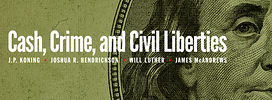J. P. Koning wants to realize the benefits of larger denominations—supernotes—while limiting the corresponding costs from crime and tax evasion that such notes would encourage. To accomplish this, he has proposed issuing supernotes that are subject to a tax. The problem with his proposal, as James McAndrews and I explain in our initial responses, is that the tax is levied on all users—not just those involved in crime and tax evasion.
In a follow-up piece, Koning notes that the market for supernotes “seems no different […] than other markets on which society has deemed it appropriate to levy a corrective tax.” He is certainly right in one respect: real-world corrective taxes tend to punish the good and bad alike. But it does not follow that such a policy makes us better off, even if “society has deemed it appropriate” (whatever that means).
Who is using large denomination notes? That is the relevant question in my mind. To see why it matters, let’s consider two somewhat extreme scenarios:
- Large denomination notes are primarily used by law-abiding citizens.
- Large denomination notes are primarily used by criminals and tax cheats.
We will also ignore the complications of welfare-improving criminals and tax cheats that I raised in my earlier response. Instead, we will assume all crime and tax-cheating is bad for society on net, and all law-abiding transacting is good for society on net.
In the first case, issuing supernotes would seem to be a good idea. Society gets all of the censorship resistance, data protection, and global back-up monetary system benefits that Koning wants at a relatively small crime and tax evasion cost. However, in this scenario, there would also seem to be little scope for improving matters with a tax on supernotes. The tax, which does not distinguish between the two user groups, mostly falls on law-abiding citizens because—by assumption—they are the primary users of large denomination notes.
In the second case, levying a tax on supernotes would seem to be a good idea. The tax mostly falls on criminals and tax cheats because—again, by assumption—they are the primary users of large denomination notes. However, in this case, it is no longer clear that supernotes should be issued at all: society incurs a large crime and tax evasion cost for little censorship resistance, data protection, and global back-up monetary system benefit.
I have focused on somewhat extreme scenarios. Perhaps the real world falls somewhere in between. But the general point remains. If the benefits of issuing supernotes are large, there is probably little scope for improving matters with a tax. If issuing a tax on supernotes improves social welfare, it is probably a bad idea to issue supernotes in the first place.
Some caveats are in order. For one, it might be the case that law-abiding citizens are much less sensitive to the tax than criminals and tax cheats. If so, much of the crime and tax evasion can be discouraged without losing the benefits realized by law-abiding citizens. Additionally, the link between user group shares and the costs and benefits of issuing supernotes might be weaker than I have suggested. A few criminals might impose very large costs on society in the first case. Similarly, a few law-abiding citizens might realize very large benefits for society in the second case. Nonetheless, for many parameterizations of this simple model, the point remains: we cannot have our cash and eat it, too.
Finally, I take issue with the implication that a prevailing policy is good because “society has deemed it appropriate.” For one, it is not obvious that society has deemed a policy appropriate simply by virtue of observing that the policy has prevailed. One can only say for certain that the policy has survived the political process. Whether that policy maximizes social utility depends on a host of institutional details. It might be the result of concentrated benefits and dispersed costs. Or, it might be the case that society has deemed a bad policy appropriate due to rationally irrational behavior: the members of society, to paraphrase H.L. Mencken, know what they want and deserve to get it good and hard. Some prevailing policies are good. Some prevailing policies are bad. We cannot judge policies based solely on their having prevailed.

